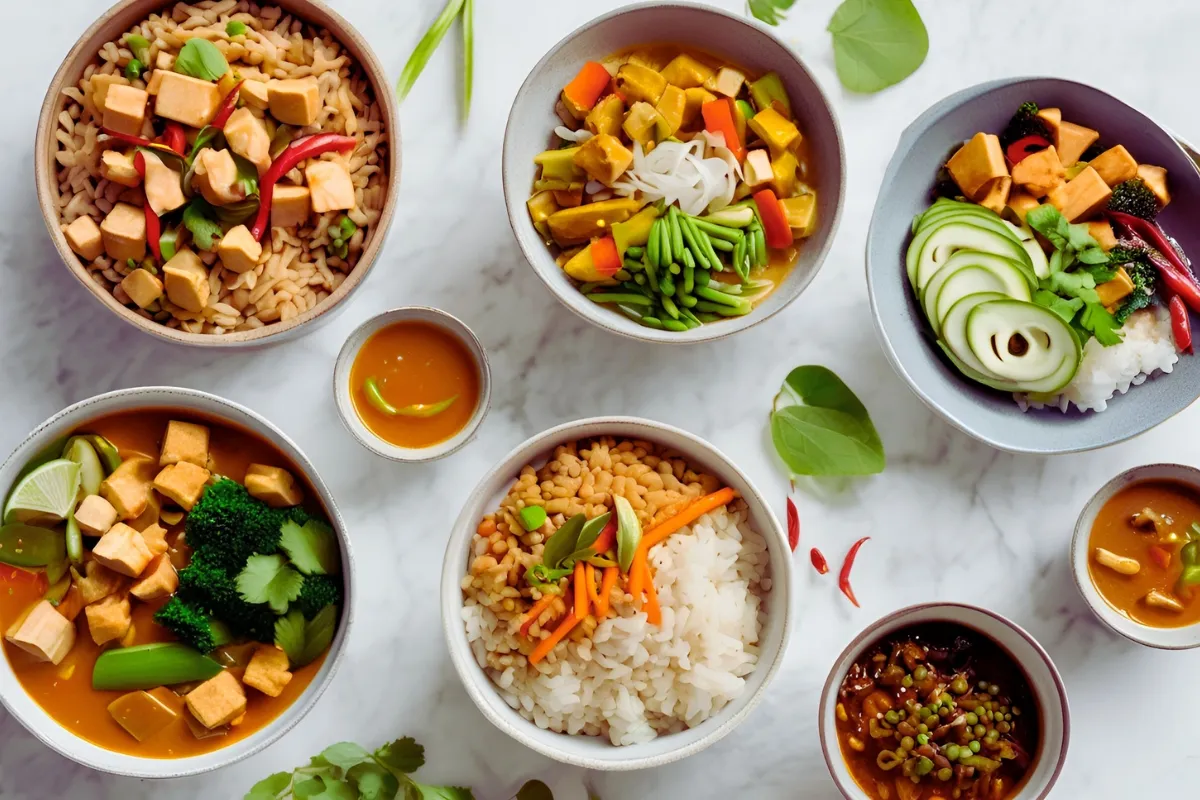Vegan Asian Recipes: A Delicious and Healthy Choice
Asian cuisine is a treasure trove of flavors, and when you go vegan with it, the possibilities are endless. From fragrant curries to tangy noodle dishes, vegan Asian recipes prove that plant-based eating doesn’t mean compromising on taste. But it’s not just the taste that makes these dishes stand out—they’re also packed with nutrients and perfect for those looking to spice up their kitchen adventures.
Why Vegan Asian Cuisine is Popular
Asian vegan dishes are gaining fans worldwide, and it’s not hard to see why. First off, many Asian cultures already use a variety of plant-based ingredients in their traditional recipes. Think tofu, tempeh, and an array of vegetables. Plus, the use of spices, herbs, and sauces like soy sauce or miso ensures every bite is bursting with flavor.
Moreover, these recipes are incredibly versatile. Whether you want something quick and easy for weeknights or a more elaborate dish to impress your friends, there’s a vegan Asian recipe for that. And let’s not forget, they’re often naturally gluten-free or can be easily adapted to fit dietary restrictions, making them accessible to nearly everyone.
Who Can Benefit from Vegan Asian Recipes?
Vegan Asian recipes cater to a wide audience, but let’s break it down into specific groups that will absolutely love them.
Busy Professionals Seeking Easy Meals
Let’s be honest—life can get hectic, and spending hours in the kitchen isn’t always an option. That’s where vegan Asian recipes shine. Many dishes, such as stir-fries and noodle bowls, can be whipped up in 30 minutes or less. Plus, you can prepare components like sauces or chopped veggies in advance, making weeknight cooking even easier.
Fitness Enthusiasts Looking for High Protein Options
For those working hard at the gym, finding plant-based protein sources is crucial. Thankfully, Asian vegan cuisine has you covered. Ingredients like edamame, tofu, and tempeh pack a protein punch, while recipes like spicy Szechuan tofu or a hearty miso soup with noodles provide the fuel you need to power through your workouts.
Families Exploring Plant-Based Dinner Ideas
Families looking to incorporate more plant-based meals into their routines will find vegan Asian recipes a fantastic option. The dishes are not only healthy but also family-friendly, offering something for every palate. Whether it’s kids who love slurping noodles or adults who crave bold flavors, these recipes bring everyone together at the dinner table.
Cultural Diversity in Asian Vegan Dishes
Asian cuisine is incredibly diverse, spanning regions like Southeast Asia, East Asia, and South Asia, each with its unique flavors and ingredients. This variety means there’s always something new to try. You can explore the creamy coconut-based curries of Thailand, the umami-packed ramen of Japan, or the spice-laden dishes of India—all in vegan form.
Common Misconceptions About Vegan Asian Recipes
Some folks might think vegan Asian recipes are just salads or that they lack the depth of traditional dishes, but nothing could be further from the truth. With the right ingredients and techniques, these recipes deliver the same complexity and satisfaction as their non-vegan counterparts. So, if you’re still skeptical, give it a shot—you might just surprise yourself.
The Basics of Vegan Asian Cooking
Vegan Asian cooking is all about simplicity, balance, and bold flavors. With the right ingredients and a few fundamental techniques, you can create restaurant-quality dishes right in your kitchen. Let’s dive into what makes these recipes so approachable and flavorful.
Essential Ingredients in Vegan Asian Cuisine
Asian vegan recipes rely heavily on fresh produce, herbs, and plant-based staples. If you’re stocking up for your next culinary adventure, here are some must-haves:
- Tofu and Tempeh: These soy-based proteins are incredibly versatile. Tofu works wonders in stir-fries and soups, while tempeh’s nutty flavor shines in marinated dishes.
- Jackfruit: This fruit has a meaty texture that makes it perfect for replicating shredded pork or chicken in dishes like bao buns.
- Noodles and Rice: From soba and udon to jasmine and sticky rice, carbs are the backbone of many Asian meals.
- Vegetables: Bok choy, mushrooms, bell peppers, and broccoli are common in many dishes.
Popular Plant-Based Alternatives
Asian cooking also has an array of vegan-friendly alternatives for dairy and meat. Coconut milk substitutes for cream in curries, while soy sauce, tamari, or liquid aminos replace fish sauce without losing the salty, umami-rich essence. Plus, mushrooms like shiitake or oyster can mimic the texture of meat in dishes like ramen or stir-fries.
Staple Asian Flavors in Vegan Dishes
What makes Asian food stand out is its depth of flavor. The magic happens when you layer these key components:
- Soy Sauce and Tamari: Essential for adding a salty, umami kick.
- Miso Paste: This fermented ingredient adds a savory depth to soups and sauces.
- Coconut Milk: Perfect for creamy curries and desserts.
- Ginger, Garlic, and Chili: The holy trinity of Asian cooking, giving dishes their signature warmth and spice.
These ingredients work together to create the perfect balance of sweet, salty, sour, and spicy that defines Asian cuisine.
Cooking Techniques for Vegan Asian Recipes
Mastering a few cooking methods will take your vegan Asian dishes to the next level.
- Stir-Frying: This quick, high-heat method locks in flavor and keeps vegetables crisp.
- Steaming: Ideal for dumplings or delicate veggies, steaming preserves nutrients and texture.
- Fermenting: Staples like kimchi and miso use fermentation to develop complex flavors.
With these techniques, you can create everything from a simple noodle bowl to an elaborate feast.
Nutritional Benefits of Vegan Asian Recipes
Asian vegan recipes are not only delicious but also packed with nutritional benefits. They’re often high in vitamins, minerals, and fiber while being naturally low in saturated fats.
High Protein Options in Vegan Asian Cuisine
Worried about getting enough protein? Asian cuisine has plenty of plant-based options to keep you fueled.
- Legumes and Lentils: Staples in South Asian cuisine, these are packed with protein and fiber.
- Edamame: A simple yet protein-rich snack or side dish.
- Seitan: A wheat-based protein that can mimic meat in texture and taste.
Combine these ingredients with whole grains like rice or quinoa for a complete protein profile.
Balancing Flavors and Nutritional Needs
Balancing a meal isn’t just about flavors—it’s about nutrition too. Asian vegan recipes naturally combine proteins, carbs, and healthy fats for a well-rounded dish. For example, a bowl of tofu stir-fry with vegetables and rice provides everything you need: energy from the rice, protein from the tofu, and fats from the cooking oil or nuts.
Easy and Delicious
Asian vegan recipes offer a world of culinary creativity, and the best part is that many of them are simple enough for beginners. Whether you’re craving a quick stir-fry, a hearty curry, or a flavorful soup, these dishes are sure to delight. Let’s explore some crowd-pleasers that are easy to make and perfect for any occasion.
Simple Vegan Asian Recipes for Beginners
If you’re just starting your vegan Asian cooking journey, these recipes are a great way to ease in.
Quick Stir-Fried Vegetables with Tofu
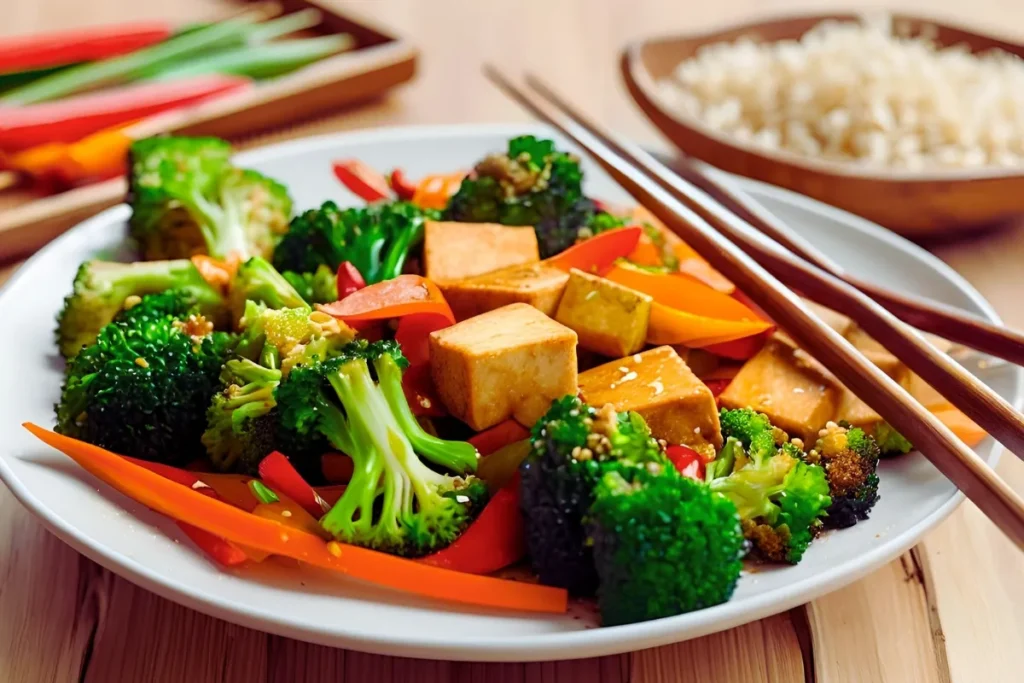
This recipe is a weeknight hero—ready in under 30 minutes and full of vibrant flavors.
Ingredients:
- 1 block of firm tofu (cubed)
- 2 cups broccoli florets
- 1 bell pepper (sliced)
- 1 carrot (julienned)
- 2 tablespoons soy sauce
- 1 tablespoon sesame oil
- 1 teaspoon minced garlic
- 1 teaspoon grated ginger
Instructions:
- Heat sesame oil in a large skillet or wok over medium-high heat.
- Add garlic and ginger, cooking until fragrant.
- Toss in the tofu and stir-fry until golden brown.
- Add the vegetables and soy sauce, cooking until tender but crisp.
- Serve hot over rice or noodles.
Nutritional Info (Per Serving):
- Calories: 230
- Protein: 12g
- Carbs: 15g
- Fat: 12g
Vegan Sushi Rolls with Avocado and Cucumber
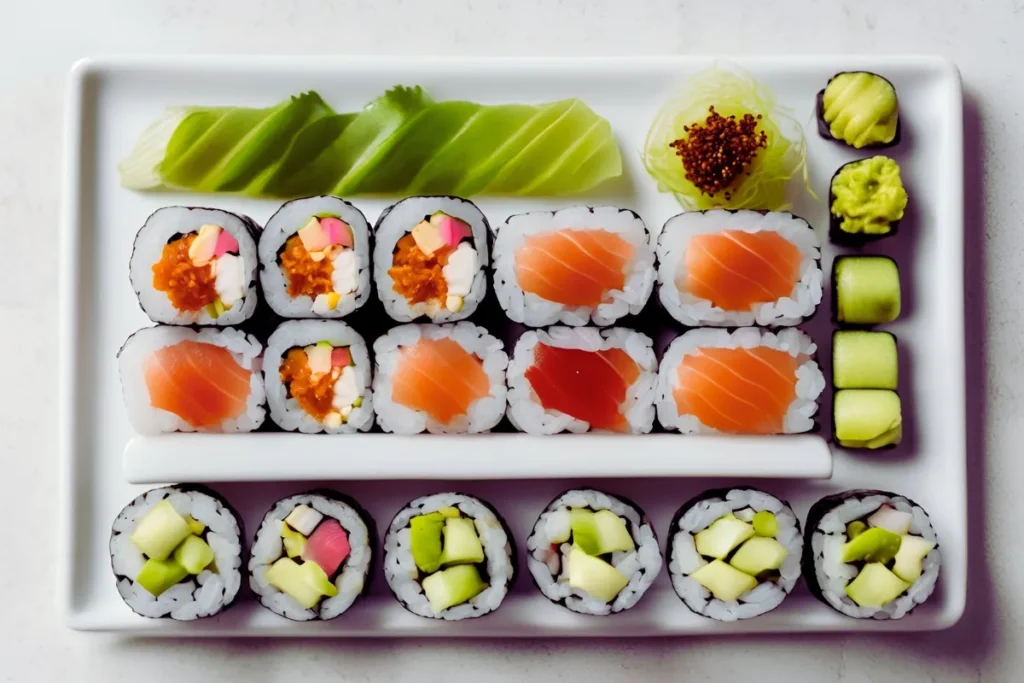
Sushi is fun to make and even more fun to eat. Plus, it’s an excellent option for meal prep.
Ingredients:
- 1 cup sushi rice (cooked and seasoned with rice vinegar)
- 4 sheets of nori (seaweed)
- 1 avocado (sliced)
- 1 cucumber (julienned)
- Soy sauce for dipping
Instructions:
- Lay a sheet of nori shiny side down on a bamboo mat.
- Spread a thin layer of sushi rice over the nori, leaving a 1-inch border.
- Arrange avocado and cucumber slices in a line near the bottom edge.
- Roll tightly, slice into pieces, and serve with soy sauce.
Nutritional Info (Per Roll):
- Calories: 180
- Protein: 3g
- Carbs: 30g
- Fat: 6g
Dinner-Friendly Vegan Asian Recipes
When you’re planning a satisfying dinner, these recipes bring comfort and flavor to the table.
Thai Green Curry with Coconut Milk
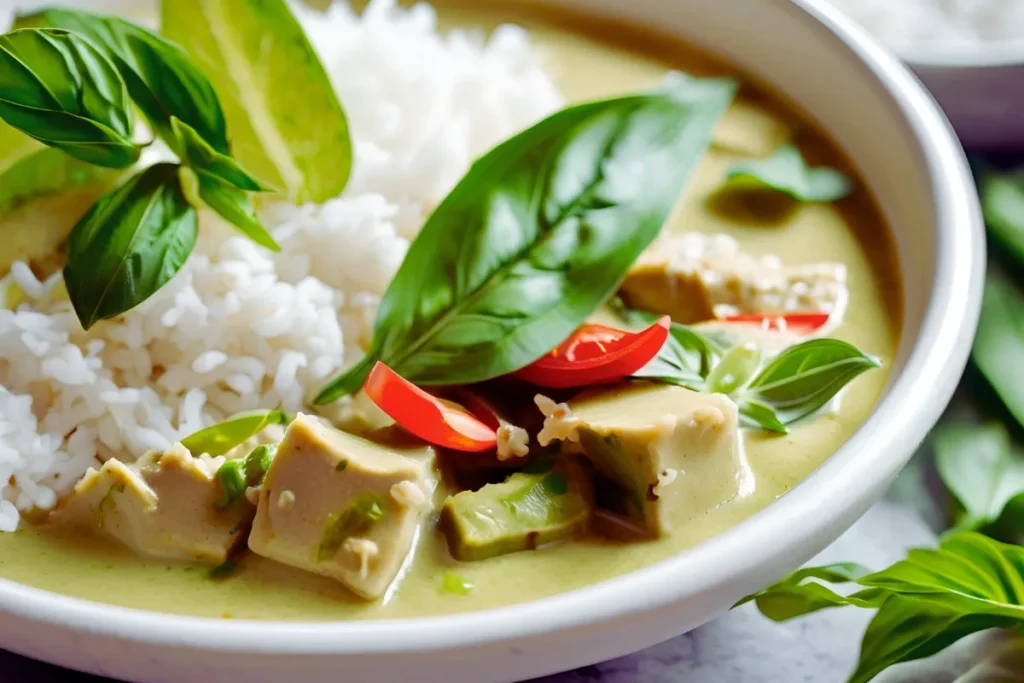
A creamy, fragrant dish that’s both comforting and customizable.
Ingredients:
- 1 can coconut milk
- 2 tablespoons green curry paste
- 1 cup sliced zucchini
- 1 cup snap peas
- 1 block tofu (cubed)
- 1 tablespoon soy sauce
Instructions:
- Heat curry paste in a large saucepan until aromatic.
- Add coconut milk and bring to a simmer.
- Stir in tofu, zucchini, and snap peas.
- Simmer until vegetables are tender, then season with soy sauce.
- Serve over jasmine rice.
Vegan Bibimbap with Seasonal Vegetables
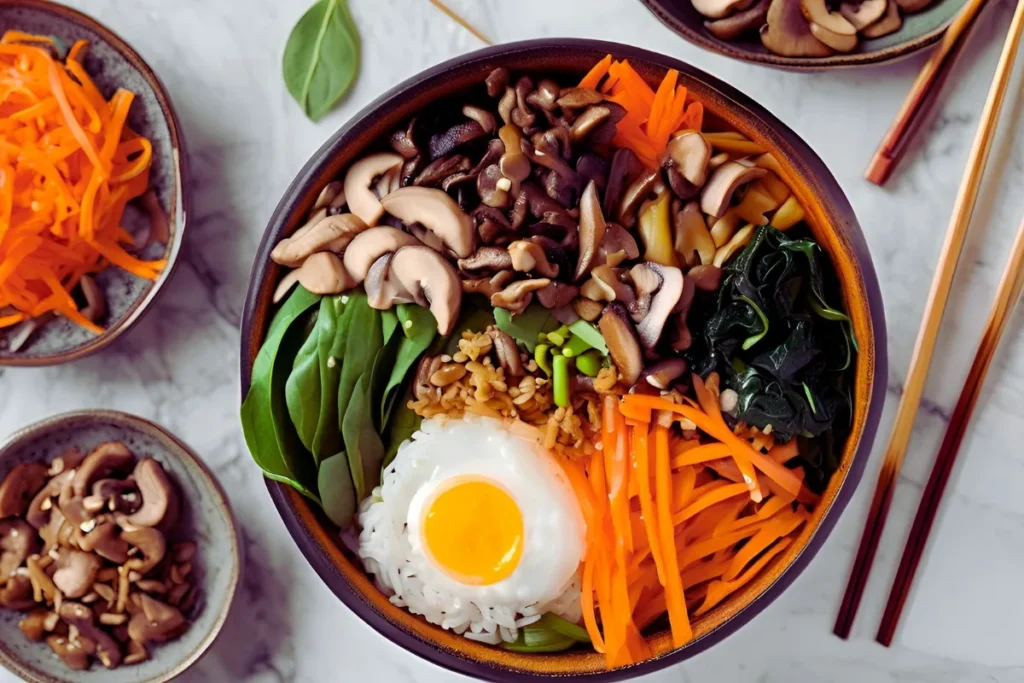
This Korean rice dish is as beautiful as it is tasty.
Ingredients:
- 2 cups cooked rice
- 1 cup spinach (blanched)
- 1 cup mushrooms (sautéed)
- 1 carrot (julienned)
- Gochujang sauce (for topping)
Instructions:
- Arrange rice in a bowl and top with prepared vegetables.
- Add a dollop of gochujang sauce and mix everything before eating.
High Protein
For those looking to pack in the protein, these recipes deliver without missing a beat.
Spicy Szechuan Tofu with Peanuts
This dish is perfect for those who enjoy bold, spicy flavors.
Ingredients:
- 1 block firm tofu (cubed)
- 1 tablespoon Szechuan peppercorns
- 2 tablespoons soy sauce
- 1 tablespoon chili paste
- 2 tablespoons roasted peanuts
Instructions:
- Toast Szechuan peppercorns in a dry pan, then grind them into powder.
- Stir-fry tofu until golden, then add soy sauce, chili paste, and peppercorn powder.
- Sprinkle peanuts on top and serve with steamed rice.
Miso Soup with Edamame and Noodles
A warm and filling soup that’s also high in protein.
Ingredients:
- 4 cups vegetable broth
- 2 tablespoons miso paste
- 1 cup cooked noodles
- 1/2 cup shelled edamame
- Green onions for garnish
Instructions:
- Heat broth in a pot and dissolve miso paste.
- Add noodles and edamame, cooking until heated through.
- Garnish with green onions before serving.
Final Thoughts on Vegan Asian Cuisine
Cooking vegan Asian recipes is more than just a way to eat healthily—it’s an opportunity to explore different cultures, experiment with flavors, and enjoy the versatility of plant-based ingredients. With so many options to choose from, there’s something for everyone, whether you’re a beginner or a seasoned cook.
FAQs
To wrap things up, let’s address some of the most common questions about vegan Asian recipes. Whether you’re a newbie or looking for specific ideas, these FAQs will help clarify everything you need to know.
Vegan Asian Recipes Easy?
What Are Some Beginner-Friendly Recipes?
Yes, vegan Asian recipes can be incredibly easy to make, even for those new to plant-based cooking. Dishes like stir-fried vegetables with tofu, miso soup, or rice paper spring rolls require minimal ingredients and basic cooking techniques. For instance, a simple stir-fry involves tossing chopped veggies and tofu into a pan with soy sauce and a splash of sesame oil—quick, nutritious, and delicious.
Tips for Simplifying Vegan Asian Cooking
If you’re short on time, focus on recipes with fewer ingredients and use pre-made sauces. Additionally, batch-cooking staples like rice, tofu, or steamed veggies can make meal prep a breeze. Don’t be afraid to experiment with frozen vegetables or canned coconut milk to save time without sacrificing flavor.
Vegan Asian Recipes for Dinner?
What Makes a Great Dinner Recipe?
A fantastic dinner recipe balances taste, texture, and nutrition. In vegan Asian cuisine, dishes like Thai green curry or vegan sushi rolls fit the bill perfectly. These meals combine protein, healthy fats, and carbs, leaving you satisfied without feeling overly heavy.
Recommendations for Balanced Dinners
For a well-rounded dinner, pair a hearty main dish with complementary sides. For example:
- Main: Vegan bibimbap with tofu and vegetables.
- Side: A light miso soup or steamed edamame.
- Drink: A refreshing jasmine tea or coconut water.
This combination ensures a variety of flavors and nutrients, making your meal both wholesome and satisfying.
High Protein Vegan Asian Recipes?
How to Add Protein to Vegan Asian Dishes?
It’s easier than you think to pack protein into vegan Asian meals. Incorporate ingredients like tofu, tempeh, or edamame into your recipes. For example, adding a handful of roasted peanuts to Szechuan tofu or topping miso soup with a boiled soy egg alternative can boost protein content significantly.
Best High Protein Ingredients to Use
Here are some top picks for high-protein ingredients in vegan Asian cuisine:
- Tofu and Tempeh: These soy-based proteins are staples in many dishes.
- Seitan: A wheat gluten protein that mimics meat textures.
- Legumes: Lentils and chickpeas are perfect for curries and soups.
- Nuts and Seeds: Peanuts, sesame seeds, and cashews add crunch and protein.
How Can I Customize Vegan Asian Recipes?
If you’re looking to adjust a recipe to fit your taste or dietary needs, the options are endless. For example, you can swap tofu for tempeh in a stir-fry or use brown rice instead of white in sushi rolls for added fiber. Adding more vegetables or experimenting with different spices can also elevate your dish while keeping it entirely plant-based.
Where Can I Find More Recipes?
You can discover an endless array of vegan Asian recipes online, in cookbooks, or even by exploring traditional Asian recipes and making simple vegan substitutions. Websites specializing in plant-based cooking often feature sections dedicated to Asian-inspired dishes. Additionally, social media platforms like Instagram and Pinterest are great for discovering creative ideas and tutorials.
Final Thoughts
Vegan Asian recipes are easy to make, versatile, and incredibly satisfying. Whether you’re just starting out or looking to add more plant-based options to your meals, these recipes are a delicious and healthy choice. From quick dinners to protein-packed meals, the possibilities are endless—and there’s always something new to try.
for more meals ideas visit our collection.

